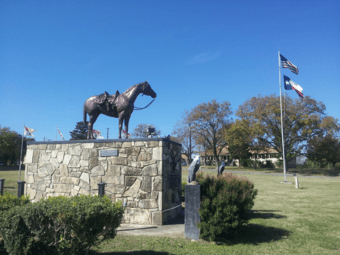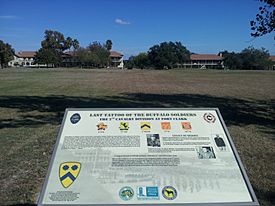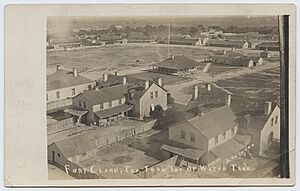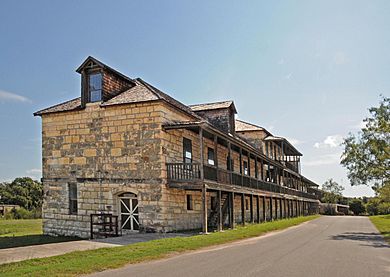Fort Clark, Texas facts for kids
Quick facts for kids |
|
|
Fort Clark Historic District
|
|

Fort Clark
|
|
| Location | Off US 90, Brackettville, Texas |
|---|---|
| Area | 88 acres (36 ha) |
| Built | 1857 |
| NRHP reference No. | 79002990 |
| Added to NRHP | December 6, 1979 |
Fort Clark was an important military base in Texas, United States. It was located near Brackettville in Kinney County, Texas. This fort helped protect the frontier long ago. Later, it became the main base for the 2nd Cavalry Division.
Today, the area is known as Fort Clark Springs. It is a special place that remembers its past. The Fort Clark Historic District was added to the National Register of Historic Places in 1979. This means it is a very important historical site. Several buildings at the fort, like the Commanding Officer's Quarters and the Guardhouse, are also recognized as Recorded Texas Historic Landmarks.
Contents
Exploring the Old Fort Clark Guardhouse Museum
The Old Fort Clark Guardhouse Museum is a cool place to visit. It is run by the Fort Clark Historical Society. The museum is inside the old guardhouse building. Here, you can see many interesting things from the fort's past.
You can find old uniforms, weapons, and photographs. There are also special items from African-American military units. These include the Black Seminole Scouts and the brave Buffalo Soldiers. These groups played a big part in the fort's history.
How Fort Clark Began
The land where Fort Clark stands was once owned by Samuel A. Maverick. In 1849, two men named William H.C. Whiting and William F. Smith found the perfect spot for a fort. They were mapping a road when they discovered the Las Moras Springs. These springs were a great source of water.
They told their leaders that the high ground near the springs would be a good place for a fort. This location was very important. It was part of a chain of army posts built after the Mexican War. The fort's main jobs were to guard the Mexican border and protect the road to El Paso. It also defended against attacks from Native American groups.
On June 20, 1852, soldiers arrived to set up the fort. They first called it Fort Riley. But General Bennett C. Riley asked for it to be named after Major John B. Clark. Major Clark was an officer who died during the Mexican–American War. So, on July 15, 1852, the fort was renamed Fort Clark.
The United States officially leased the land from Maverick. Soon, buildings for soldiers and officers were built. A hospital and a two-story storehouse were added later. Stone quarters for the commanding officer were finished in 1857. These became the fort's headquarters in 1873.
The Town of Brackettville
A nearby village called Las Moras was founded in 1852. It was started by a local merchant named Oscar B. Brackett. In 1854, Texas Rangers came to Fort Clark. They helped the regular soldiers patrol the roads.
The town was renamed Brackett in Oscar's honor in 1856. It became Brackettville in 1873 when it got a post office. It was an important stop for stagecoaches traveling the San Antonio-El Paso Road. The town was very lively back then. However, its importance faded when the railroad was built ten miles away.
Fort Clark During the Civil War
The American Civil War brought changes to Fort Clark. On March 19, 1861, Confederate troops took over the fort. Captain George Sykes and his Union soldiers surrendered without a fight. But they did try to prevent the Confederate flag from being raised. They also set fire to their barracks as they left. Captain Sykes quickly helped put out the fire to save the buildings.
After the war started, Confederate soldiers guarded Fort Clark. But in August 1862, all Confederate troops left the fort. On December 12, 1866, U.S. troops returned and took control again. More buildings were added in 1868, including stone barracks and a large wooden stable.
Battles During the Indian Wars

Fort Clark was part of a system of frontier forts in Texas. These forts included Griffin, Concho, Davis, and Bliss. Their job was to protect settlers and control Native American groups.
The Seminole-Negro Indian Scouts were based at Fort Clark for many years. These brave scouts had protected the Mexican border for two decades. The United States Army then hired them to serve as scouts. Under Lieutenant John Lapham Bullis, they were very important in the Indian campaigns. Four of these scouts even received the Medal of Honor for their bravery. A Seminole community settled near the fort in 1872. Their descendants still live in Brackettville today.
Colonel Ranald Mackenzie and the 4th US Cavalry were also stationed here. In 1873, Mackenzie led a raid into Mexico. His goal was to stop Native American raids into Texas. His soldiers and Seminole-Negro scouts attacked several villages. They burned lodges and captured prisoners and horses.
These actions, though protested by Mexico, greatly reduced Native American attacks from Mexico. Mackenzie was followed by Lieutenant Colonel William Rufus Shafter. Shafter continued to lead successful campaigns. Under him, Fort Clark became home to the 10th U.S. Cavalry and the 24th and 25th U.S. Infantry regiments. These were regiments of black soldiers. Native Americans called them "buffalo soldiers." The Buffalo Soldiers served with great honor, helping to make southwest Texas safer.
Shafter's determined efforts into Mexico caused tension with the Mexican government. But his actions helped bring the "Indian problem" along the border under control. By the end of the 1870s, the raids had mostly stopped. In 1884, the U.S. government bought the entire Fort Clark property.
Fort Clark in World War II
Fort Clark played a role in World War II. In 1941, the 112th Cavalry Regiment trained there. This unit was part of the Texas National Guard. They trained with horses before being sent to fight in the Pacific.
Later, the black 9th United States Cavalry arrived at Fort Clark. Elements of this regiment had served at the fort back in 1875. In 1943, the 2nd Cavalry Division was formed at Fort Clark. This was the army's last unit that still used horses.
More than 12,000 troops were stationed at Fort Clark during this time. They trained there until they were sent to Europe in 1944. During the war, Fort Clark also had a German prisoner-of-war camp. In June 1944, the government decided to close Fort Clark. It was one of the last horse-cavalry posts in the country. The fort officially closed in early 1946. Later that year, it was sold and became a "guest ranch."
The Fort Closes Its Doors
Cavalry training at Fort Clark ended in January 1944. That year, the U.S. Army stopped using the cavalry as a separate branch. It was combined with the armor branch. The base was officially closed in 1946.
Gallery
See also







